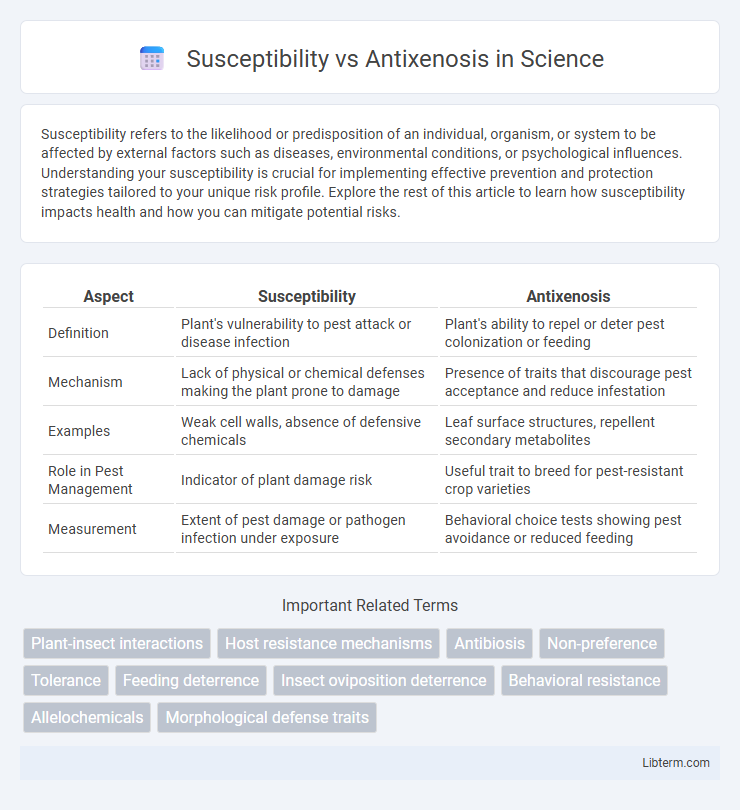Susceptibility refers to the likelihood or predisposition of an individual, organism, or system to be affected by external factors such as diseases, environmental conditions, or psychological influences. Understanding your susceptibility is crucial for implementing effective prevention and protection strategies tailored to your unique risk profile. Explore the rest of this article to learn how susceptibility impacts health and how you can mitigate potential risks.
Table of Comparison
| Aspect | Susceptibility | Antixenosis |
|---|---|---|
| Definition | Plant's vulnerability to pest attack or disease infection | Plant's ability to repel or deter pest colonization or feeding |
| Mechanism | Lack of physical or chemical defenses making the plant prone to damage | Presence of traits that discourage pest acceptance and reduce infestation |
| Examples | Weak cell walls, absence of defensive chemicals | Leaf surface structures, repellent secondary metabolites |
| Role in Pest Management | Indicator of plant damage risk | Useful trait to breed for pest-resistant crop varieties |
| Measurement | Extent of pest damage or pathogen infection under exposure | Behavioral choice tests showing pest avoidance or reduced feeding |
Understanding Plant-Insect Interactions
Susceptibility in plant-insect interactions refers to the degree to which a plant is vulnerable to insect attack, often resulting in damage or reduced growth. Antixenosis, also known as non-preference, describes a plant's ability to deter or repel insects, reducing the likelihood of infestation. Understanding these mechanisms aids in developing pest-resistant crops by harnessing natural plant traits that minimize insect damage without relying on chemical pesticides.
Defining Susceptibility in Plant Defense
Susceptibility in plant defense refers to the degree to which a plant is vulnerable to pest or pathogen attack, characterized by the inability to effectively resist or tolerate infestation. It contrasts with antixenosis, which is a plant's trait that deters pests by reducing their preference for the plant through physical or chemical barriers. Understanding susceptibility involves assessing plant responses, such as symptom severity, pathogen proliferation, and impact on plant health, critical for breeding resistant crop varieties.
What is Antixenosis?
Antixenosis is a plant resistance mechanism that deters or repels herbivorous insects, reducing pest colonization and feeding. Unlike susceptibility, where plants are prone to damage and infestation, antixenosis minimizes the likelihood of pest attack through factors such as surface texture, chemical repellents, or altered plant morphology. This resistance strategy is crucial in integrated pest management for enhancing crop protection without relying solely on chemical pesticides.
Key Differences Between Susceptibility and Antixenosis
Susceptibility refers to the degree to which a plant or organism is vulnerable to pest or pathogen attack, often resulting in damage or disease progression. Antixenosis, on the other hand, describes a plant's ability to deter or repel pests through traits such as non-preference, morphological barriers, or chemical repellents. Key differences include susceptibility involving active damage and infestation, whereas antixenosis involves passive resistance without necessarily killing the pest.
Mechanisms of Susceptibility in Plants
Mechanisms of susceptibility in plants often involve molecular recognition failures where plants cannot effectively detect or respond to specific pathogens, allowing infection and colonization by pests. This includes compromised immune receptors or signaling pathways that fail to activate defensive responses such as the production of antimicrobial compounds or structural barriers. Understanding these susceptibility mechanisms helps differentiate them from antixenosis, which involves plant traits that deter pest colonization before infection.
Mechanisms of Antixenosis: Plant Traits and Strategies
Antixenosis in plants involves traits that deter insect herbivores from feeding or oviposition, including morphological features like trichomes, waxy cuticles, and leaf toughness, as well as chemical deterrents such as secondary metabolites and volatile organic compounds. These mechanisms disrupt insect host recognition and reduce pest colonization by creating an unfavorable environment. By enhancing antixenosis traits, plants effectively minimize damage without relying on pest mortality, differentiating this strategy from susceptibility, where plants lack such defensive attributes.
Importance in Integrated Pest Management
Susceptibility refers to a plant's vulnerability to pest infestation, which can lead to significant crop damage and yield loss. Antixenosis, a key mechanism in Integrated Pest Management (IPM), involves plant traits that deter pest colonization and feeding, reducing the need for chemical interventions. Emphasizing antixenosis enhances sustainable pest control by minimizing pesticide use and promoting ecological pest resistance in agricultural systems.
Examples from Agricultural Crops
Susceptibility in agricultural crops refers to the inherent vulnerability of plants to pests or diseases, such as the high susceptibility of tomato plants to late blight caused by Phytophthora infestans. Antixenosis, also known as non-preference, involves crop traits that deter pest colonization, exemplified by the use of resistant rice varieties that repel the brown planthopper (Nilaparvata lugens). Understanding the contrast between susceptibility and antixenosis aids in developing integrated pest management strategies to enhance crop resilience.
Breeding for Enhanced Antixenosis
Breeding for enhanced antixenosis targets the development of crop varieties that naturally deter pests by altering plant traits such as surface texture, volatile emissions, or secondary metabolites, reducing pest colonization and feeding. Unlike susceptibility, which reflects a plant's inherent vulnerability to pest damage, antixenosis leverages genetic resistance to minimize pest attraction and infestation. Advanced breeding techniques, including marker-assisted selection and genomic tools, accelerate the identification and incorporation of antixenotic traits into cultivars, promoting sustainable pest management and reducing reliance on chemical pesticides.
Future Perspectives in Plant Resistance Research
Future perspectives in plant resistance research emphasize integrating susceptibility and antixenosis mechanisms to develop durable crop protection. Advances in genomics and phenotyping enable precise identification of susceptibility genes and antixenosis traits, facilitating targeted breeding and gene editing. Harnessing these approaches promises innovative, sustainable solutions to enhance plant resilience against evolving pests and diseases.
Susceptibility Infographic

 libterm.com
libterm.com